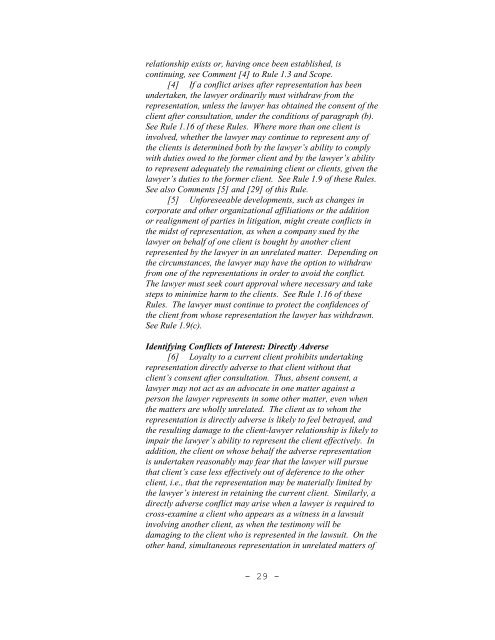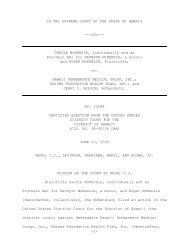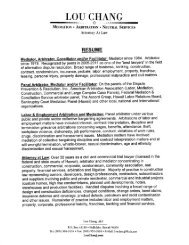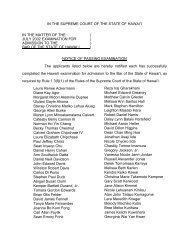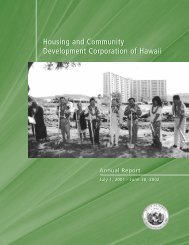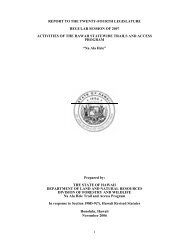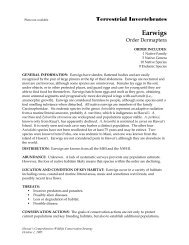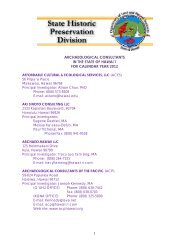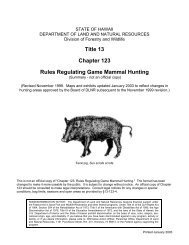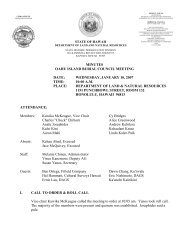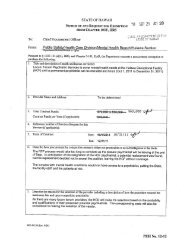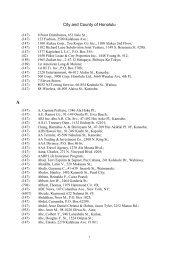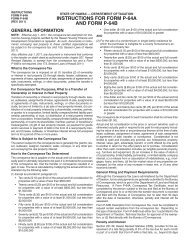amendments to the Hawaii Rules of Professional Conduct
amendments to the Hawaii Rules of Professional Conduct
amendments to the Hawaii Rules of Professional Conduct
Create successful ePaper yourself
Turn your PDF publications into a flip-book with our unique Google optimized e-Paper software.
elationship exists or, having once been established, is<br />
continuing, see Comment [4] <strong>to</strong> Rule 1.3 and Scope.<br />
[4] If a conflict arises after representation has been<br />
undertaken, <strong>the</strong> lawyer ordinarily must withdraw from <strong>the</strong><br />
representation, unless <strong>the</strong> lawyer has obtained <strong>the</strong> consent <strong>of</strong> <strong>the</strong><br />
client after consultation, under <strong>the</strong> conditions <strong>of</strong> paragraph (b).<br />
See Rule 1.16 <strong>of</strong> <strong>the</strong>se <strong>Rules</strong>. Where more than one client is<br />
involved, whe<strong>the</strong>r <strong>the</strong> lawyer may continue <strong>to</strong> represent any <strong>of</strong><br />
<strong>the</strong> clients is determined both by <strong>the</strong> lawyer’s ability <strong>to</strong> comply<br />
with duties owed <strong>to</strong> <strong>the</strong> former client and by <strong>the</strong> lawyer’s ability<br />
<strong>to</strong> represent adequately <strong>the</strong> remaining client or clients, given <strong>the</strong><br />
lawyer’s duties <strong>to</strong> <strong>the</strong> former client. See Rule 1.9 <strong>of</strong> <strong>the</strong>se <strong>Rules</strong>.<br />
See also Comments [5] and [29] <strong>of</strong> this Rule.<br />
[5] Unforeseeable developments, such as changes in<br />
corporate and o<strong>the</strong>r organizational affiliations or <strong>the</strong> addition<br />
or realignment <strong>of</strong> parties in litigation, might create conflicts in<br />
<strong>the</strong> midst <strong>of</strong> representation, as when a company sued by <strong>the</strong><br />
lawyer on behalf <strong>of</strong> one client is bought by ano<strong>the</strong>r client<br />
represented by <strong>the</strong> lawyer in an unrelated matter. Depending on<br />
<strong>the</strong> circumstances, <strong>the</strong> lawyer may have <strong>the</strong> option <strong>to</strong> withdraw<br />
from one <strong>of</strong> <strong>the</strong> representations in order <strong>to</strong> avoid <strong>the</strong> conflict.<br />
The lawyer must seek court approval where necessary and take<br />
steps <strong>to</strong> minimize harm <strong>to</strong> <strong>the</strong> clients. See Rule 1.16 <strong>of</strong> <strong>the</strong>se<br />
<strong>Rules</strong>. The lawyer must continue <strong>to</strong> protect <strong>the</strong> confidences <strong>of</strong><br />
<strong>the</strong> client from whose representation <strong>the</strong> lawyer has withdrawn.<br />
See Rule 1.9(c).<br />
Identifying Conflicts <strong>of</strong> Interest: Directly Adverse<br />
[6] Loyalty <strong>to</strong> a current client prohibits undertaking<br />
representation directly adverse <strong>to</strong> that client without that<br />
client’s consent after consultation. Thus, absent consent, a<br />
lawyer may not act as an advocate in one matter against a<br />
person <strong>the</strong> lawyer represents in some o<strong>the</strong>r matter, even when<br />
<strong>the</strong> matters are wholly unrelated. The client as <strong>to</strong> whom <strong>the</strong><br />
representation is directly adverse is likely <strong>to</strong> feel betrayed, and<br />
<strong>the</strong> resulting damage <strong>to</strong> <strong>the</strong> client-lawyer relationship is likely <strong>to</strong><br />
impair <strong>the</strong> lawyer’s ability <strong>to</strong> represent <strong>the</strong> client effectively. In<br />
addition, <strong>the</strong> client on whose behalf <strong>the</strong> adverse representation<br />
is undertaken reasonably may fear that <strong>the</strong> lawyer will pursue<br />
that client’s case less effectively out <strong>of</strong> deference <strong>to</strong> <strong>the</strong> o<strong>the</strong>r<br />
client, i.e., that <strong>the</strong> representation may be materially limited by<br />
<strong>the</strong> lawyer’s interest in retaining <strong>the</strong> current client. Similarly, a<br />
directly adverse conflict may arise when a lawyer is required <strong>to</strong><br />
cross-examine a client who appears as a witness in a lawsuit<br />
involving ano<strong>the</strong>r client, as when <strong>the</strong> testimony will be<br />
damaging <strong>to</strong> <strong>the</strong> client who is represented in <strong>the</strong> lawsuit. On <strong>the</strong><br />
o<strong>the</strong>r hand, simultaneous representation in unrelated matters <strong>of</strong><br />
- 29


